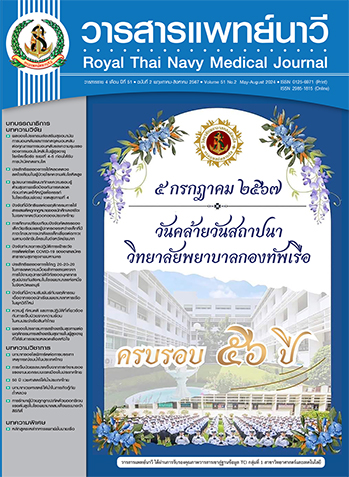รูปแบบการพัฒนาทักษะความรอบรู้ด้านสุขภาพเพื่อป้องกันการคลอดก่อนกำหนดให้หญิงตั้งครรภ์ในโรงเรียนพ่อแม่ เขตสุขภาพที่ 4
Main Article Content
บทคัดย่อ
การคลอดก่อนกำหนดของหญิงตั้งครรภ์เป็นปัญหาที่สำคัญด้านงานอนามัยแม่และเด็ก มีผลโดยตรงต่อร่างกายของทารกและมารดา ด้านจิตใจส่งผลให้เกิดความเครียด วิตกกังวล รวมถึงผลกระทบทางด้านเศรษฐกิจต้องสูญเสียค่าใช้จ่ายในการดูแลรักษาต่อเนื่องเป็นระยะเวลานาน การศึกษานี้มีวัตถุประสงค์เพื่อพัฒนาและประเมินผลรูปแบบการพัฒนาทักษะความรอบรู้ด้านสุขภาพเพื่อป้องกันการคลอดก่อนกำหนดให้หญิงตั้งครรภ์ในโรงเรียนพ่อแม่ เขตสุขภาพที่ 4 วิธีการศึกษาเป็นการวิจัยและพัฒนา ประกอบด้วยการดำเนินงาน 2 ระยะ คือ 1) พัฒนารูปแบบการพัฒนาทักษะความรอบรู้ด้านสุขภาพในการป้องกันการคลอดก่อนกำหนดให้หญิงตั้งครรภ์ และ 2) นำรูปแบบการพัฒนาทักษะความรอบรู้ด้านสุขภาพในการป้องกันการคลอดก่อนกำหนดให้หญิงตั้งครรภ์ไปใช้และประเมินผล กลุ่มตัวอย่าง คือ หญิงตั้งครรภ์ที่มารับบริการฝากครรภ์ที่โรงพยาบาล 7 แห่ง จำนวน 60 คน การเก็บรวบรวมข้อมูลใช้การวิเคราะห์เอกสาร และการใช้แบบสอบถาม ข้อมูลเชิงคุณภาพวิเคราะห์ด้วยการวิเคราะห์เชิงเนื้อหา ส่วนข้อมูลเชิงปริมาณวิเคราะห์ด้วยสถิติเชิงพรรณนา และสถิติอ้างอิง Paired t- test
ผลการศึกษา พบว่า 1. รูปแบบที่พัฒนาขึ้นประกอบด้วยการดำเนินงาน 11 ขั้นตอน ได้แก่ 1) สื่อสาร/เชิญชวนและคัดเลือกหญิงตั้งครรภ์เข้าร่วมพัฒนาทักษะความรอบรู้ด้านสุขภาพ 2) พูดโน้มน้าวหรือจูงใจกลุ่มเป้าหมายเพื่อกำหนดเป้าหมายในการคลอดครบกำหนด 3) ฝึกทักษะการสืบค้น กลั่นกรองและตรวจสอบความน่าเชื่อถือ 4) สืบค้นหัวข้อ “ปัญหาของทารกคลอดก่อนกำหนด” 5) สืบค้นหัวข้อ “ทำอย่างไรไม่ให้เกิดการคลอดก่อนกำหนด” 6) ฝึกทักษะไต่ถาม 7) ฝึกทักษะการตัดสินใจ 8) ฝึกทักษะการตัดสินใจด้วยปัญหาใหม่ 9) ฝึกทักษะการนำไปใช้ 10) ทบทวนการฝึกทักษะ 11) เล่าสิ่งที่ต้องปฏิบัติในการป้องกันการคลอดก่อนกำหนด ที่ทำได้ดีโดยไม่จำกัดจำนวนเรื่อง 2. หลังการทดลองใช้รูปแบบฯ พบว่า หญิงตั้งครรภ์มีความรู้เกี่ยวกับการคลอดก่อนกำหนด มีความรอบรู้ด้านสุขภาพในการป้องกันการคลอดก่อนกำหนด และมีพฤติกรรมป้องกันการคลอดก่อนกำหนดสูงกว่าก่อนการทดลอง (p < .01)
Article Details

อนุญาตภายใต้เงื่อนไข Creative Commons Attribution-NonCommercial-NoDerivatives 4.0 International License.
เอกสารอ้างอิง
Hesketh KR, Evenson KR. Prevalence of US pregnant women meeting 2015 ACOG physical activity guidelines. Am J Prev Med 2016;51(3):1-3.
Women ACoHCfU. ACOG Committee Opinion No.524: Opioid abuse, dependence, and addiction in pregnancy. Obstetrics and gynecology 2012;119(5):1070-6.
Leelahapongsathorn W, Chantathip P J. Evidence based practice guidline in labour room at Kingnarai Hospital. Journal of Nursing Division 2016;43(special):46-62. (in Thai).
Flicek P, Amode MR, Barrell D, Beal K, Billis K, Brent S, et al. Nucleic acids research. Ensembl 2014;42(1):749-55.
Kongrod S, Chaiyarit C. Effectiveness of an education program on knowledge, attitude and practice of pregnant women with premature labour. Journal of Health Science 2020;29(6):1055-61. (in Thai).
Moglia PP. Premature birth. Hackensack: Salem Press; 2019.
Nutbeam D. Health Literacy as a public health goal: a challenge for contemporary health education and communication strategies into the 21st century. Health Promotion International 2000;15(3):259-67.
Duggan L, McCarthy S, Curtis LM, Woif MS, Noone C, Iggins JR, et al. Associated between health literacy and beliracy and beliefs about medicines in an lrish obstetric population. J Health Commun 2014;19(2):106-14.
Sitkulanan P. Nursing care for pregnant women at risk of preterm labour. Nursing Science Journal of Thailand 2007;25(2):4-12. (in Thai).
Thawaro J. Comparison of clinical outcomes of late term preterm infant with full term infant in Nongbualamphu hospital. Sanpasitthiprasong Medical Journal 2021;42(2):53-61. (in Thai).
Pattanapongthorn J. School manual’ s parents for children "Good health, good brain, good mood, happiness". 3nd ed. Department of Health, Ministry of Public Health: New Thammada Press; 2016. (in Thai).
Dale Edgar. Audio-Visual Methods in Teaching. 3rd ed. New York: Holt, Rinehart & Winston; 1969.
Kaeodumkoeng K, Chaiyaparn N, Boonkla S. A program development of promoting health literacy on disease prevention and control in Public Health Officers. Thai Journal of Health Education 2021;40(2);187-201. (in Thai).
Polit D F, Beck C T. Nursing research: generating and assessing evidence for nursing practice Eighth Edition. Philadelphia, Pa: Lippincott Williams & Wilkins; 2008.
Lahukarn B, Kala S, Krischaroen S. The Effects of an education and progressive muscle relaxation program on stress among pregnant women with preterm labor pain. The Southern College Network Journal of Nursing and Public Health 2019;6(2):1-13. (in Thai).
Bloom S. Learning for mastery. Evaluation comment. Center for the study of instruction program. University of California at Los Angeles; 1986.
Khokkaew A, Chulert P, Kulpanich M. The effects of a health promotion program on knowledge and self-care behavior for pregnant teenagers. Journal of MCU Nakhondhat 2022;9(8):17-31. (in Thai).
Choeisuwan V. Health Literacy: Concept and application for nursing practice. RTN Med J 2017;44(3):183-197. (in Thai).

